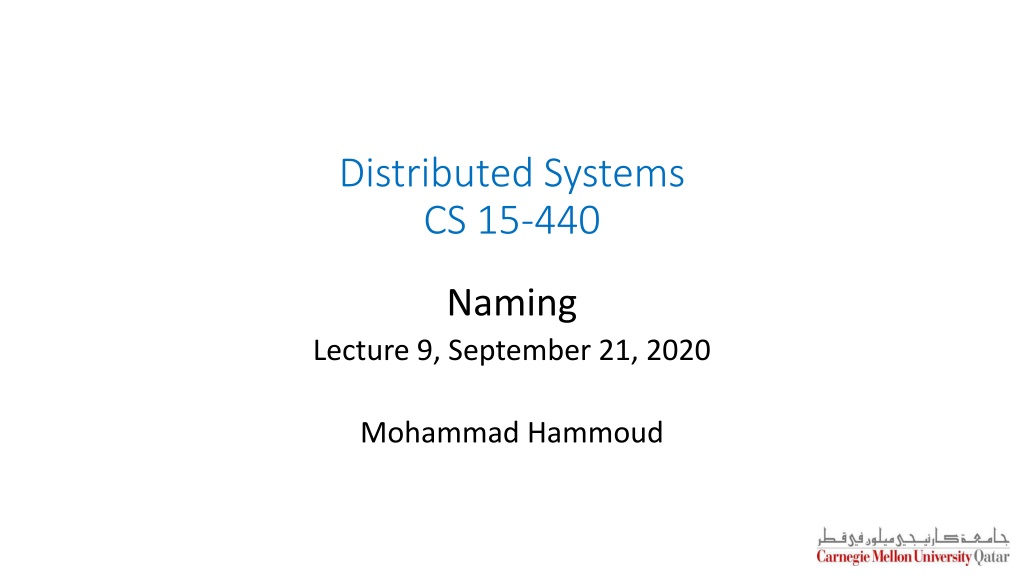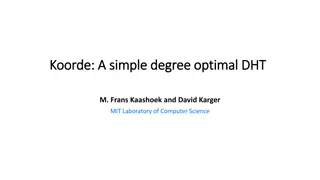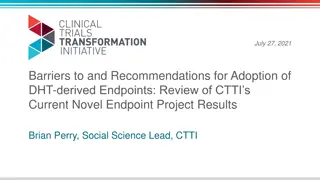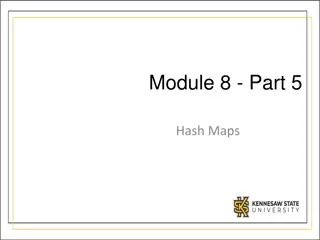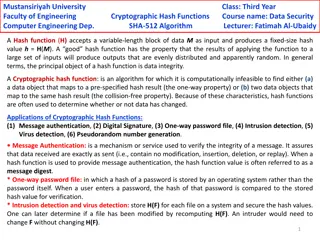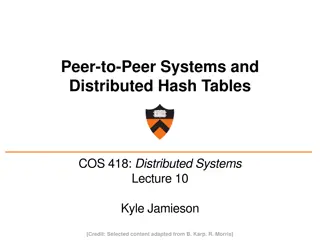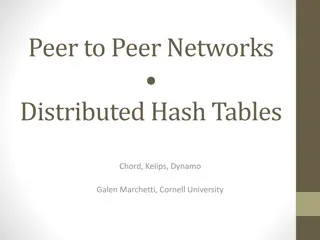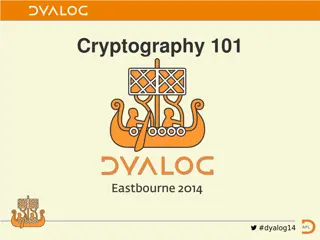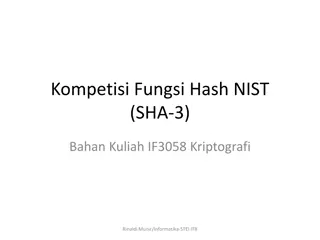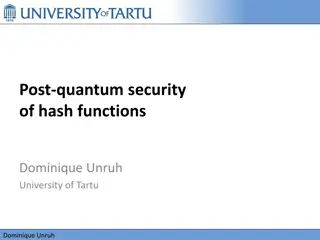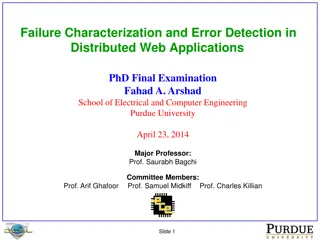Understanding Distributed Hash Table (DHT) in Distributed Systems
In this lecture, Mohammad Hammoud discusses the concept of Distributed Hash Tables (DHT) in distributed systems, focusing on key aspects such as classes of naming, Chord DHT, node entities, key resolution algorithms, and the key resolution process in Chord. The session covers various components of DHT, including flat naming, structured naming, and attribute-based naming, as well as the mechanisms involved in mapping keys to values across distributed nodes. Additionally, it explores the challenges in key resolution and how Chord DHT improves efficiency by reducing time complexity.
Download Presentation

Please find below an Image/Link to download the presentation.
The content on the website is provided AS IS for your information and personal use only. It may not be sold, licensed, or shared on other websites without obtaining consent from the author. Download presentation by click this link. If you encounter any issues during the download, it is possible that the publisher has removed the file from their server.
E N D
Presentation Transcript
Distributed Systems CS 15-440 Naming Lecture 9, September 21, 2020 Mohammad Hammoud
Today Last Session: Naming- Part I Today s Session: Naming Part II Announcements: PS2 is due on September 24 by midnight Quiz I is on September 28 P1 is due on Oct 5
Classes of Naming Flat naming Structured naming Attribute-based naming
4. Distributed Hash Table (DHT) DHT is a distributed system that provides a lookup service similar to a hash table (key, value) pair is stored in the nodes participating in the DHT The responsibility for maintaining the mapping from keys to values is distributed among the nodes Any participating node can serve in retrieving the value for a given key We will study a representative DHT known as Chord DATA KEY DISTRIBUTED NETWORK Hash function Pink Panther ASDFADFAD Participating Nodes Hash function DGRAFEWRH cs.qatar.cmu.edu Hash function 86.56.87.93 4PINL3LK4DF
Node n (node with id=n) Entity with k Chord 000 Chord assigns an m-bit identifier (randomly chosen) to each node A node can be contacted through its network address 003 Node 000 004 008 Alongside, it maps each entity to a node Entities can be processes, files, etc., Node 005 040 079 Mapping of entities to nodes Each node is responsible for a set of entities An entity with key k falls under the jurisdiction of the node with the smallest identifier id >= k. This node is known as the successor of k, and is denoted by succ(k) Node 010 Node 301 Map each entity with key k to node succ(k)
A Nave Key Resolution Algorithm The main issue in DHT is to efficiently resolve a key k to the network location of succ(k) Given an entity with key k, how to find the node succ(k)? 19 00 31 01 1. All nodes are arranged in a logical ring according to their IDs 2. Each node p keeps track of its immediate neighbors: succ(p) and pred(p) 3. If p receives a request to resolve key k : If pred(p) < k <=p, node p will handle it Else it will forward it to succ(n) or pred(n) 30 02 29 03 28 04 27 05 26 06 25 07 24 08 23 09 22 10 Solution is not scalable: As the network grows, forwarding delays increase Key resolution has a time complexity of O(n) 21 11 20 12 19 13 18 14 17 15 16 = Active node with id=n = No node assigned to key p n p
Key Resolution in Chord 1 04 2 04 Chord improves key resolution by reducing the time complexity to O(log n) 1. All nodes are arranged in a logical ring according to their IDs 2. Each node p keeps a table FTp of at-most m entries. This table is called Finger Table FTp[i] = succ(p + 2(i-1)) NOTE: FTp[i] increases exponentially 3. If node p receives a request to resolve key k : Node p will forward it to node q with index j in Fp where q = FTp[j] <= k < FTp[j+1] 3 09 4 09 1 01 1 09 5 18 2 01 2 09 3 01 00 3 09 31 01 4 04 30 02 26 4 14 29 03 5 14 5 20 28 04 27 05 26 06 25 07 1 11 1 28 24 08 2 11 2 28 3 14 23 09 3 28 4 18 If k > FTp[m], then node p will forward it to FTp[m] If k < FTp[1], then node p will forward it to FTp[1] 4 01 5 28 22 10 5 09 21 11 1 14 20 12 2 14 19 13 1 21 3 18 18 14 17 15 2 28 16 4 20 1 18 1 20 3 28 5 28 2 18 2 20 4 28 3 18 3 28 5 04 4 28 4 28 5 01 5 04
Chord Join and Leave Protocol In large-scale distributed systems, nodes dynamically join and leave (voluntarily or due to failures) 00 31 01 30 02 29 03 28 04 27 05 Node 4 is succ(2+1) 26 06 If a node p wants to join: It contacts arbitrary node, looks up for succ(p+1), and inserts itself into the ring 25 07 24 08 02 Who is succ(2+1) ? 23 09 22 10 If node p wants to leave: It contacts pred(p)and succ(p+1) and updates them 21 11 20 12 19 13 18 14 17 15 16
Chord Finger Table Update Protocol For any node q, FTq[1] should be up-to-date It refers to the next node in the ring Protocol: Periodically, request succ(q+1) to return pred(succ(q+1)) If q = pred(succ(q+1)), then information is up-to-date Otherwise, a new node p has been added to the ring such that q < p < succ(q+1) FTq[1] = p Request p to update pred(p) = q Similarly, node p updates each entry i by finding succ(p + 2(i-1))
Exploiting Network Proximity in Chord The logical organization of nodes in the overlay network may lead to inefficient message transfers Node k and node succ(k +1) may be far apart Chord can be optimized by considering the network location of nodes 1.Topology-Aware Node Assignment Two nearby nodes get identifiers that are close to each other 2.Proximity Routing Each node qmaintains r successors for ith entry in the finger table FTq[i] now refers to r successor nodes in the range [p + 2(i-1), p + 2i -1] To forward the lookup request, pick one of the r successors closest to the node q
Classes of Naming Flat naming Structured naming Attribute-based naming
Structured Naming Structured names are composed of simple human-readable names Names are arranged in a specific structure Examples: File-systems utilize structured names to identify files /home/userid/work/dist-systems/naming.txt Websites can be accessed through structured names www.cs.qatar.cmu.edu
Name Spaces Structured names are organized into name spaces A name space is a directed graph consisting of: Leaf nodes Each leaf node represents an entity A leaf node generally stores the address of an entity (e.g., in DNS), or the state of (or the path to) an entity (e.g., in file systems) Directory nodes Directory node refers to other leaf or directory nodes Each outgoing edge is represented by (edge label, node identifier) Each node can store any type of data I.e., State and/or address (e.g., to a different machine) and/or path
Name Spaces: An Example Looking up for the entity with name /home/steen/mbox Data stored in n1 n0 keys home n2: elke n3: max n4: steen n1 /keys n5 elke steen max n4 n2 n3 Leaf node twmrc mbox Directory node
Name Resolution The process of looking up a name is called name resolution Closure mechanism: Name resolution cannot be accomplished without an initial directory node The closure mechanism selects the implicit context from which to start name resolution Examples: www.qatar.cmu.edu: start at the DNS Server /home/steen/mbox: start at the root of the file-system
Name Linking The name space can be effectively used to link two different entities Two types of links can exist between the nodes: 1. Hard Links 2. Symbolic Links
1. Hard Links /home/steen/keys is a hard link to /keys There is a directed link from the hard link to the actual node n0 home keys Name resolution: Similar to the general name resolution n1 /keys n5 elke steen max keys n4 n2 n3 Constraint: There should be no cycles in the graph twmrc mbox
2. Symbolic Links /home/steen/keys is a symbolic link to /keys Symbolic link stores the name of the original node as data n0 home keys Name resolution for a symbolic link SL First resolve SL s name Read the content of SL Name resolution continues with content of SL n1 /keys n5 elke steen max n4 n2 n3 keys twmrcmbox Constraint: No cyclic references should be present n6 Data stored in n6 /keys
Mounting of Name Spaces Two or more name spaces can be merged transparently by a technique known as mounting With mounting, a directory node in one name space will store the identifier of the directory node of another name space Network File System (NFS) is an example where different name spaces are mounted NFS enables transparent access to remote files
Example of Mounting Name Spaces in NFS Machine A Machine B Name Server for foreign name space Name Space 1 Name Space 2 remote home vu steen mbox nfs://flits.cs.vu. nl/home/steen OS OS Name resolution for /remote/vu/home/steen/mbox in a distributed file system
Distributed Name Spaces In large-scale distributed systems, it is essential to distribute name spaces over multiple name servers Distribute the nodes of the naming graph Distribute the name space management Distribute the name resolution mechanisms
Layers in Distributed Name Spaces Distributed name spaces can be divided into three layers Consists of high-level directory nodes Directory nodes are jointly managed by different administrations Global Layer Contains mid-level directory nodes Directory nodes grouped together in such a way that each group is managed by an administration Administrat -ional Layer Contains low-level directory nodes within a single administration The main issue is to efficiently map directory nodes to local name servers Managerial Layer
Comparison of Name Servers at Different Layers Global Administrational Managerial Organization Department Worldwide Geographical scale of the network Few Many Many None or few Vast numbers None Total number of nodes Number of replicas Lazy Immediate Immediate Update propagation Yes Milliseconds Sometimes Immediate Yes Seconds Is client side caching applied? Responsiveness to lookups
Distributed Name Resolution Distributed name resolution is responsible for mapping names to addresses in a system where: Name servers are distributed among participating nodes Each name server has a local name resolver We will study two distributed name resolution algorithms: 1. Iterative Name Resolution 2. Recursive Name Resolution
1. Iterative Name Resolution 1. Client hands over the complete name to root name server 2. Root name server resolves the name as far as it can, and returns the result to the client The root name server returns the address of the next-level name server (say, NLNS) if address is not completely resolved 3. Client passes the unresolved part of the name to the NLNS 4. NLNS resolves the name as far as it can, and returns the result to the client (and probably its next-level name server) 5. The process continues untill the full name is resolved
1. Iterative Name Resolution An Example <a,b,c> = structured name in a sequence #<a> = address of node with name a Resolving the name ftp.cs.vu.nl
2. Recursive Name Resolution Approach: Client provides the name to the root name server The root name server passes the result to the next name server it finds The process continues till the name is fully resolved Drawback: Large overhead at name servers (especially, at the high-level name servers)
2. Recursive Name Resolution An Example <a,b,c> = structured name in a sequence #<a> = address of node with name a Resolving the name ftp.cs.vu.nl
Classes of Naming Flat naming Structured naming Attribute-based naming
Attribute-based Naming In many cases, it is much more convenient to name, and look up entities by means of their attributes Similar to traditional directory services (e.g., yellow pages) However, the lookup operations can be extremely expensive They require to match requested attribute values, against actual attribute values, which might require inspecting all entities Solution: Implement basic directory service as a database, and combine it with traditional structured naming system We will study Light-weight Directory Access Protocol (LDAP); an example system that uses attribute-based naming
Light-weight Directory Access Protocol (LDAP) LDAP directory service consists of a number of records called directory entries Each record is made of (attribute, value) pairs LDAP standard specifies five attributes for each record Directory Information Base (DIB) is a collection of all directory entries Each record in a DIB is unique Each record is represented by a distinguished name E.g., /C=NL/O=Vrije Universiteit/OU=Comp. Sc.
Directory Information Tree in LDAP All the records in the DIB can be organized into a hierarchical tree called Directory Information Tree (DIT) LDAP provides advanced search mechanisms based on attributes by traversing the DIT Example syntax for searching all Main_Servers in Vrije Universiteit: search("&(C = NL) (O = Vrije Universiteit) (OU = *) (CN = Main server)")
Summary Naming and name resolutions enable accessing entities in a distributed system Three types of naming: Flat Naming Broadcasting, forward pointers, home-based approaches, Distributed Hash Tables (DHTs) Structured Naming Organizes names into Name Spaces Distributed Name Spaces Attribute-based Naming Entities are looked up using their attributes
Next Class More on Naming
